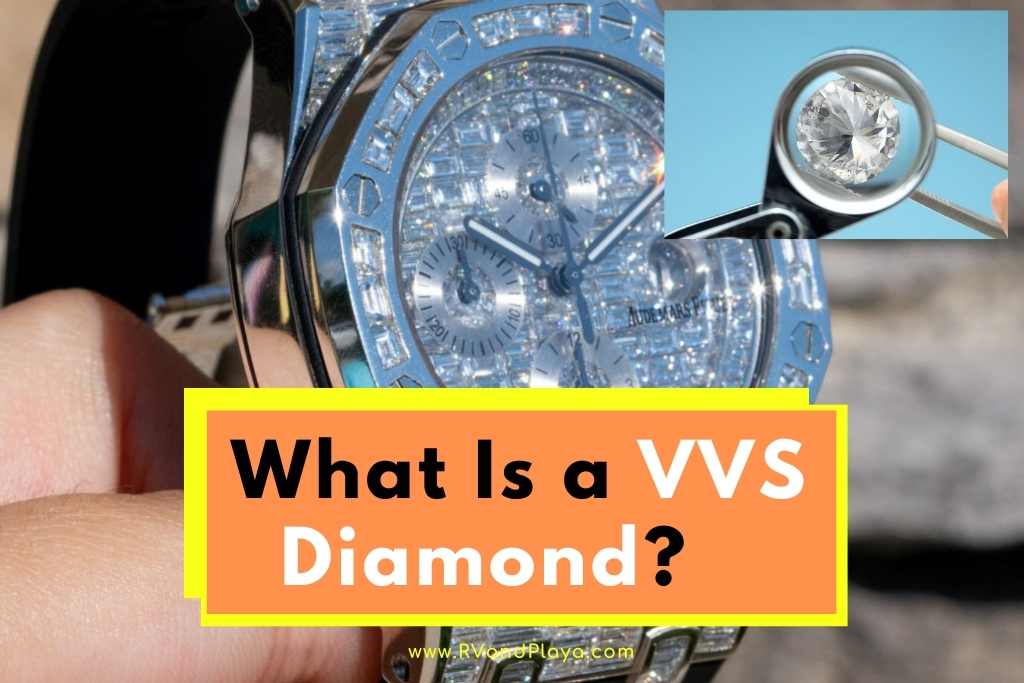Do you know what a VVS diamond is? Well, you are at the perfect place to find the answer to such a question.
Diamonds are graded on four factors that gemologists refer to as the 4 Cs. These are used to help give the diamond a value. Clarity is graded for the number and size of the inclusions the stone has.
VVS diamonds are very very slightly included, so they’re closer to the flawless end of the scale. Diamond clarity is graded on a specific scale that indicates the number of inclusions a stone has and how visible they are. The scale ranges from FL for a flawless diamond to an I3 for a diamond with inclusions that are visible to the naked eye.
This article is about the clarity level VVS. VVS diamonds have two levels, 1 and 2. Keep reading to learn all you need to know about this level of clarity for a true diamond gemstone.
Table of Contents
What Is a VVS Diamond?
VVS stands for very very slightly included. These diamonds have inclusions but they’re not detectable by the naked eye. In fact, they’re hard to see with magnification, as well.
VVS diamonds have inclusions that are so minuscule, even a trained professional may have a hard time seeing them under 10x magnification.
Read also >> Are VVS Diamonds Lab Created? (Real Diamonds + More)
Read also >> Are VVS Diamonds Real? (Buying Guide)
Read also >> Are VVS Diamonds Expensive? (All You Need To Know)
What Is the Difference Between VVS1 and VVS2?
VVS1 diamonds look flawless to most people, even under magnification. The inclusions or flaws are so tiny they have to be under extremely high magnification to see them at all.
A VVS2 diamond has tiny inclusions that start to show up under 10x magnification to a trained eye. They still can’t be seen by the naked eye though.
Both VVS levels have extremely good clarity. Most of these stones have high price tags, also. It depends on the color, cut, and clarity, as well though.
How Much Does a VVS Diamond Cost?
The price is affected by all of the 4 Cs but clarity is a big factor in the value of a diamond.
A 1 carat VVS1 diamond with average color and round cut is about $5,500.
A VVS2 diamond with around the same color and the same shape and size costs about $200 less.
| Carat | FL | VVS | SI |
|---|---|---|---|
| 0.50 | $3,500 | $1,200 | $930 |
| 1.00 | $7,500 | $5,500 | $4,850 |
| 2.00 | $21,000 | $17,000 | $12,500 |
Are VVS or VS Diamonds Better?
VVS diamonds have better clarity than VS. VVS diamonds are nearer to flawless than VS. VS diamonds have inclusions that are detectable under 10x magnification.
Some VS diamonds may have an inclusion that can be seen without magnification. Most have slight inclusions that are somewhat easy to see under 10x magnification to a trained gemologist.
VVS stands for very very slightly, while VS stands for very slightly. Both have good clarity but VVS is better.
Are VVS Diamonds Rare?
VVS diamonds are rare. Generally, the closer you get to flawless, the rarer the diamonds are. VVS diamonds are rare enough to be more valuable than the majority of diamonds.
VS diamonds are somewhat rare, also. They’re usually priced lower than VVS stones, depending on the other factors of the 4 Cs. You can see prices that are nearly 30% lower on VS diamonds sometimes.
What’s Better Than VVS Diamonds?
There are two levels of clarity above VVS. The highest level is FL. This is a flawless diamond that has no detectable inclusions. These are extremely rare and have high price tags because of it.
Just below FL is IF, or internally flawless. IF diamonds do not have any inclusions but they do have blemishes.
You won’t be able to see the blemishes without 10x magnification, however.
VVS diamonds are the next level after IF.
- Save an Average of $350* on Lab-Created Diamonds
- James Allen is the leader in online diamond sales
What’s After VVS?
The next clarity levels are VS1 and VS2. The difference between VVS and VS is in the size of the inclusions. VS inclusions are larger and easier to see than VVS flaws.
After the two VS levels are five more clarity levels. SI is the slightly included range. There are two categories under SI.
Both SI1 and SI2 diamonds have inclusions that are easier for gemologists to see. Most of these can still only be seen under 10x magnification.
The final three levels are I1, I2, and I3. All of these have inclusions that any expert is able to see under a magnifier. Some have inclusions that are easily detectable by the naked eye, also.
Is It Worth Buying a VVS Diamond?
VVS diamonds are worth buying. They hold value better than diamonds with more inclusions.
Though the value of diamonds has dropped in recent years, those with near flawless clarity have held their value more successfully.
If you do buy a VVS diamond, it’s best to get one that is certified by the GIA and keep the paperwork.
Should you ever decide to resell your VVS diamond, it will be much easier to do with the paperwork supporting the diamond’s cut, color, clarity, and carat grades.
Where Can I Buy VVS Diamonds?
It may be harder to find VVS diamonds in stock in retail jewelry stores anymore. Jewelers don’t stock as many diamonds as they used to.
If you want a VVS diamond, you may have to special order it because they’re not stocked much anymore.
There are online brokers that make it easy to custom order what you’re looking for. That may be the best way to find the VVS diamond you want. Just be sure to do your homework so you purchase from a reputable seller.
What’s the Best Cut for a VVS Diamond?
The great thing about VVS diamonds is you don’t have to try to hide any inclusions or blemishes because they’re so small, the naked eye can’t see them anyway.
That being the case, you can go with pretty much any cut for a VVS diamond. The clarity is so good, they will sparkle and shine no matter the cut.
Is a VVS Diamond as Good as a Flawless Diamond?
The answer to this question is all in how you look at it. It depends on your priorities. If you wear a VVS diamond on your finger, no one can tell it’s not actually flawless. It appears flawless to the naked eye.
What we’re getting at here is you’ll save money when buying a VVS diamond because true flawless diamonds go for about triple the price.
True flawless diamonds are extremely rare. So, if all you want to do is wear a diamond that looks stunning and flawless, then VVS is as good as a flawless.
Where they will differ is with resale. An FL diamond has a much better resale value than a VVS. It’s important to note here that you’ll have to have the grading report to backup your claim of the clarity when you’re selling a diamond.
If you have a certificate of authenticity from the GIA, that’s even better.
Are VVS Diamonds Natural?
Some VVS diamonds are natural and some are lab grown. Natural VVS diamonds are more rare than lab grown.
Some people mistakenly think that lab grown diamonds don’t have any inclusions. They do, though. Lab grown diamonds are graded on the 4 Cs just the same as natural diamonds.
There are inclusions in lab grown stones due to the molten metal solution they’re grown in.
What’s More Expensive, a VVS Natural Diamond or VVS Lab Grown?
The lab grown counterparts to natural diamonds are less expensive. They’re grown in much less time and can be mass produced. That brings their value down.
Lab grown diamonds don’t hold value the same way natural diamonds do, either. If you’re looking for something with better resale potential, you’ll want to purchase a natural VVS diamond.
What Color Diamond Is Best?
Diamond color is graded on a letter scale. It ranges from D to Z. D is the best color, which means it’s basically colorless. A D diamond has virtually no color, so it is clear.
On the other end of the scale is the Z diamond. Z diamonds look like they’re a bit yellow or brown. A diamond with a Z color grade is significantly less expensive than a D diamond.
Conclusion
VVS diamonds are so close to flawless you won’t know the difference. Even under 10x magnification, it’s almost impossible to find the inclusions within the stone.
Two subcategories exist within the VVS level of clarity. VVS1 diamonds have inclusions so small a professional can’t see them with 10x magnification.
VVS2 stones have slightly larger inclusions that a highly trained gemologist may be able to detect.
If you want the look of flawless with a lower price tag, a VVS diamond is your best bet.
James Allen is the leader in online diamond sales. Their imaging technology is the same as inspecting a diamond with a jeweler's loupe. They have the largest exclusive loose diamond inventory online and fantastic prices.
They also have the nicest collection of lab created diamonds online. Save 10% off select lab grown diamonds and 25% off ring settings during limited time sale!
WHAT WE LOVE ABOUT THEM:
- No questions asked returns within 30 days of shipment. James Allen will send you a paid shipping label to return the ring.
- Lifetime Warranty
- Free International Shipping
- Free prong tightening, repolishing, rhodium plating and cleaning every 6 months
- Provide insurance appraisals
- One free resizing within 60 days of purchase
- Free ring inscriptions
- Best-in-class high quality imagery of all diamonds in stock
- 24/7 Customer Service
- Best-in-class packaging
References
https://4cs.gia.edu/en-us/blog/vvs-diamond-versus-vs-diamond/
https://www.gia.edu/gia-about/4cs-clarity
Recent Posts
Lindsey, do you know if VVS diamonds are real or fake? This is one of the questions our readers ask a lot. Well, we´ve got you covered. If you are in the market for a diamond, or even just...
Most of us know there are naturally occurring diamonds and lab created diamonds. Both are beautiful. Both can be set to make exquisite jewelry. But naturally occurring diamonds are typically more...


